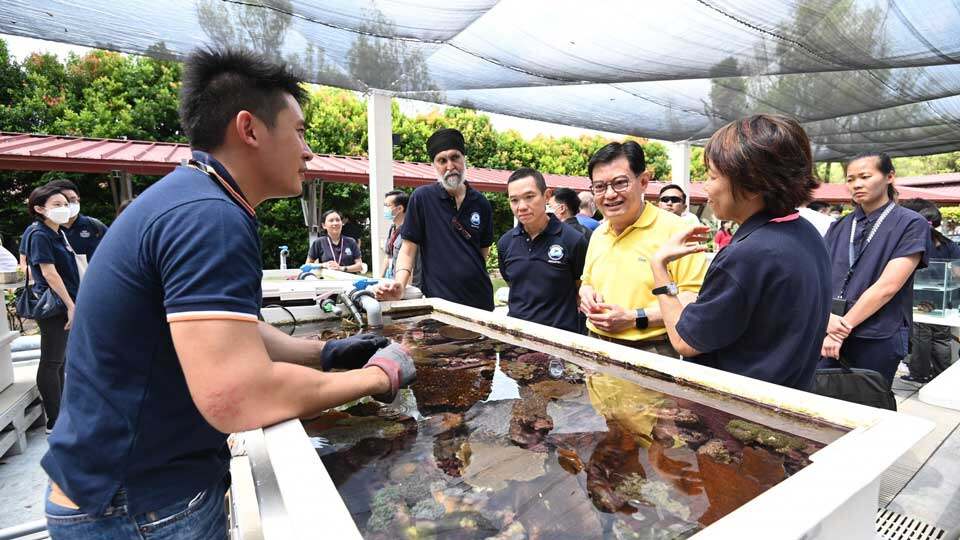As Singapore’s marine science community celebrates 20 years of prolific research on St John’s Island, the St John’s Island National Marine Laboratory gears up to play a larger regional role in marine science.


Marine science is vital to the health and vitality of the regional seas around Singapore, which supports the nation’s survival and success. Against this backdrop, the St John’s Island National Marine Laboratory (SJINML) is ramping up to play a key role in establishing Singapore as a regional nexus for marine science research and education.
Hosted and operated by the National University of Singapore (NUS) and funded by National Research Foundation, Singapore (NRF Singapore) as a vital National Research Infrastructure, SJINML will also nurture manpower capabilities for the marine and off-shore industries. Equipped with a strong understanding of the marine environment and biodiversity, researchers trained by the laboratory will provide industry with a better understanding of the business impact on the marine environment and promote greener innovations and solutions.
Under the refreshed vision, the laboratory will also spearhead regional partnerships to conserve and rehabilitate regional oceans and mitigate the impacts of climate change.
SJINML’s new vision was articulated through the Marine Science R&D Open House held on 22 October 2022 on St John’s Island to celebrate 20 years of marine science research. The event was graced by Guest-of-Honour, Deputy Prime Minister Heng Swee Keat, who is also the Coordinating Minister for Economic Policies and Chairman of NRF Singapore.
The Open House brought together the marine science research community and galvanised research efforts towards emerging themes in climate change, biodiversity conservation and aquaculture. Visitors had the opportunity to interact with SJINML researchers to learn more about their research projects, and participate in guided tours, workshops and science seminars.


20 years of marine science research excellence
Launched in October 2002, the St John’s Island marine laboratory is Singapore’s only offshore marine research facility. It was first operated as a research laboratory of the NUS Tropical Marine Science Institute.
Situated in the Singapore Straits off the southern tip of Singapore and surrounded by rich biodiversity in the form of natural rocky shores, coral reefs and mangroves supporting different flora and fauna, the marine laboratory presents an excellent site for studying tropical organisms and ecosystems.
NRF Singapore designated the laboratory as a National Research Infrastructure in June 2016 to support marine research for the country. This was also due to the strategic importance of enhancing capabilities in marine science and marine environment, as well as the marine laboratory’s research value and potential user base.
“Oceans play a critical role in regulating global climate. As we try to address climate change, it is timely to consider our relationship with the extraordinary biodiversity in the seas around us, and build capabilities and networks to take our achievements in marine science research to a new and higher level by extending research to a larger regional context, beyond our borders. The team of dynamic and dedicated scientists at SJINML are excited to contribute towards this ambitious yet important goal,” said Professor Koh Lian Pin, Member of St John’s Island National Marine Laboratory Governing Board, and Director, Tropical Marine Science Institute, National University of Singapore.
He added, “By growing a multidisciplinary and broad-based approach in marine science, and integrating our knowledge with the larger regional model, Singapore will be better positioned to improve the sustainability of the living environment around us.”
Dr Jasbir Singh, NRF Director for National Research Infrastructure, said, “The necessary pillars in building a regional marine research nexus are already in Singapore. As one of the vital national research infrastructures in Singapore, the laboratory will nurture a pipeline of environmentally-aware marine research leaders who can add value to businesses embarking on their sustainability journeys.The new nexus will also establish strong networks across the region and leverage the large and comprehensive body of knowledge in marine science to model and predict environmental changes across a range of scientific and geographical considerations.”
“This will help us develop better ways of safeguarding our marine environment and biodiversity, and contribute to Singapore’s transformation into a City in Nature – a key pillar under our Green Plan.”
Dr Serena Teo, Facility Director at SJINML, highlighted that the national marine laboratory aims to play a key role in establishing Singapore as a regional nexus for marine science research and education. This includes setting up a first-in-Singapore national network of next-generation research marine buoys and data platform for monitoring of Singapore’s seawater quality to strengthen climate change and ecological research.
Monitoring the seas to save our ocean
To further broaden its capabilities as an NRI, SJINML has embarked on a five-year project to build a national network of next-generation research marine buoys and data platforms. The first of its kind in Singapore, the Marine Environment Sensing Network (MESN) is a system that enables real-time monitoring of seawater quality to strengthen climate change and ecological research.
Bringing together expertise from NUS, Agency for Science Technology and Research, Nanyang Technological University Singapore, and the Singapore University of Technology and Design, the S$9 million interdisciplinary project will enhance existing capabilities in marine engineering, marine ecology and biochemistry, and data technology.
Three next-generation research buoys will be set up by 2025, each equipped with sensors that collect environmental parameters relevant to marine climate change science such as pH, temperature and mineral content. Designed to continuously monitor over 30 environmental parameters in real time, the sensors on the research buoys will send research grade environmental data to the cloud for processing and eventually uploading on a data portal. The buoys will also enable the test-bedding of marine technologies and sensing capabilities, and the first one is expected to be launched at sea by the end of 2022.
The high-quality data from the public-access portal will allow researchers to access information on Singapore’s seawater quality readily. MESN will also serve as a resource repository for the growing web of ocean observatories that deliver data on the state of our oceans and address scientific questions regarding our marine environment.
By developing capabilities for long-term environment monitoring for research, the MESN hopes to establish Singapore as a key player in global monitoring networks.
Discovering new marine species in Singapore and beyond
Growing and strengthening research linkages is a key priority of SJINML. NUS researchers from SJINML have collaborated with regional partners to discover new species of marine life.
One noteworthy example is the South Java Deep Sea Biodiversity Expedition 2018 (SJADES 2018), involving researchers from NUS and the Research Center for Oceanography of the Indonesian Institute of Sciences.
SJADES 2018 proved to be a boost for studying tanaids, which are small crustaceans that scientists believe are likely to play important ecological roles but know very little about. A total of 40 species of tanaids collected from the expedition are new to science, increasing the tanaidacean diversity of Indonesia by two-fold, from 34 species to 74 species. This is also the region’s largest discovery of deep-sea tanaids, due to a lack of systematic sampling before SJADES 2018.
In total, the researchers collected more than 12,000 creatures during the 14-day voyage to survey the unexplored deep seas off the southern coast of West Java, Indonesia.


Protecting our coastlines
A team of researchers from the Singapore Centre for Environmental Life Sciences Engineering (SCELSE) are conducting studies on the roles of microbial communities in the health of marine ecosystems. These include a study examining the interactions between corals and macroalgae – that may contribute to reef resilience in urbanised coastal areas.
Another study demonstrated that marine snow could facilitate the persistence of disease vectors in the environment which may be an important consideration for improving safe aquaculture farming practices and food security.
For more information on SJINML, please visit: https://sjinml.nus.edu.sg/







































